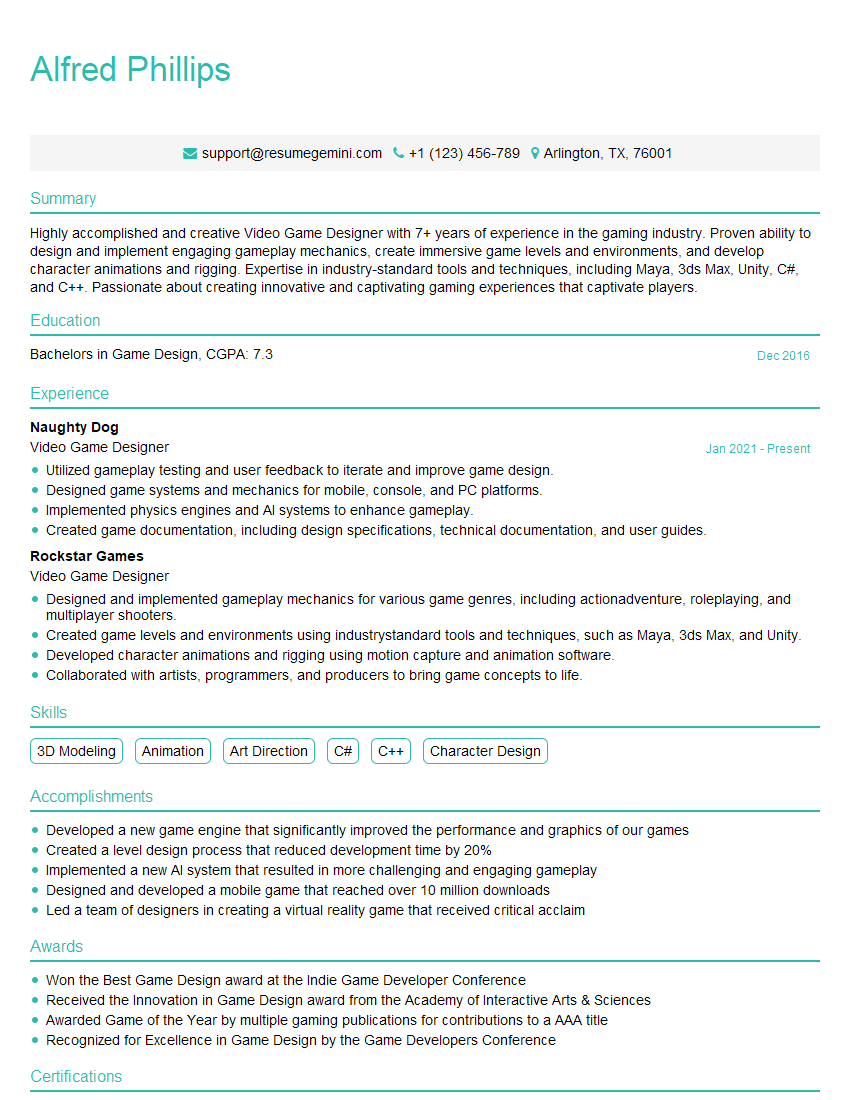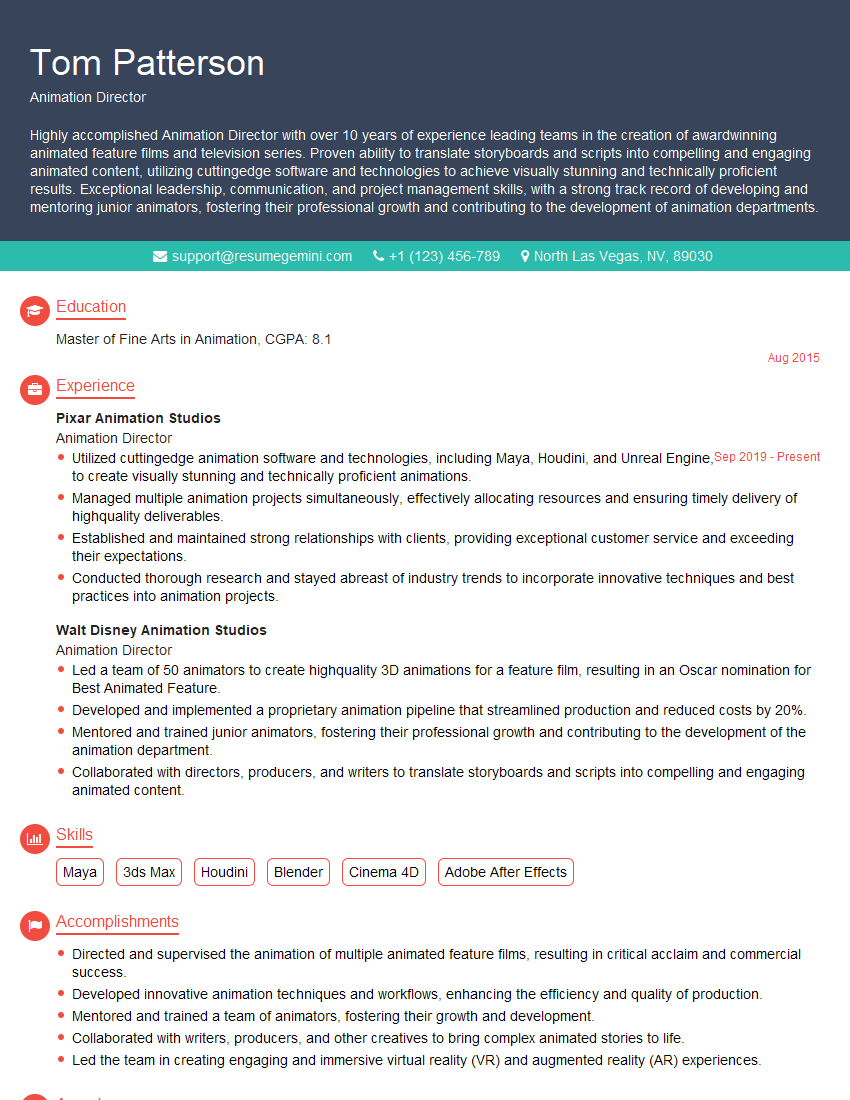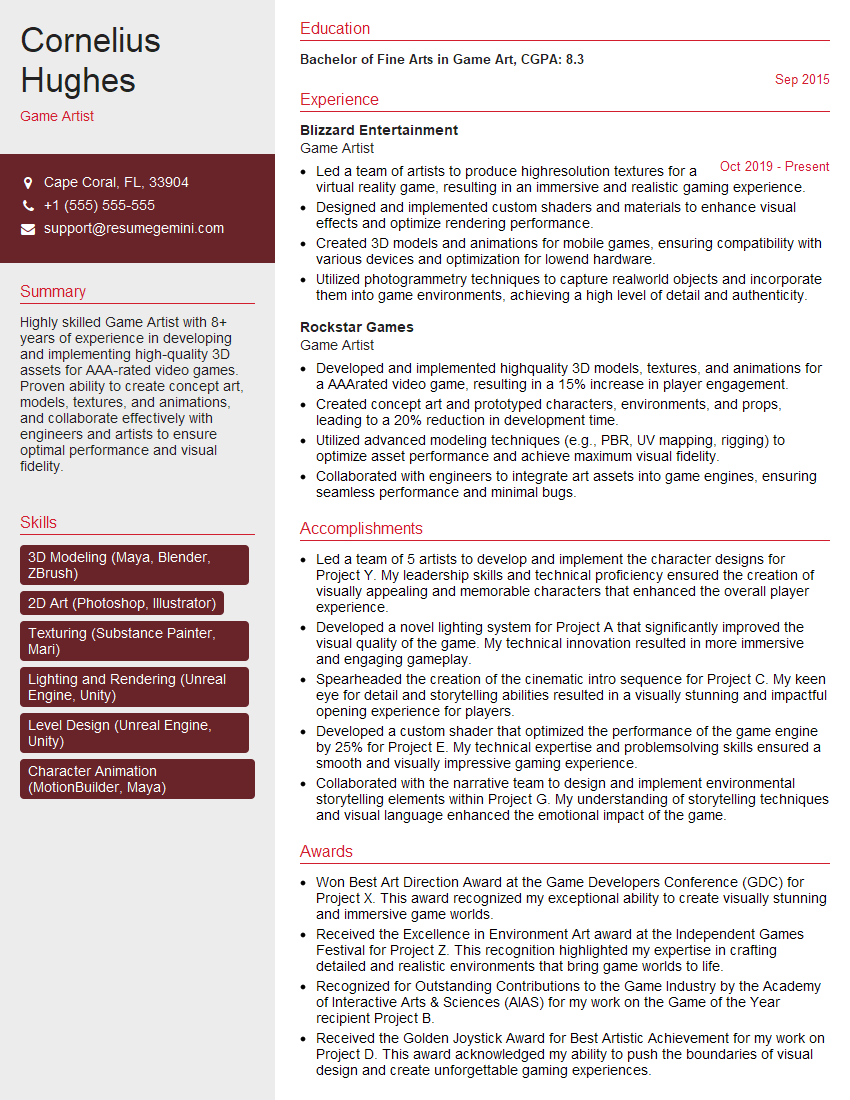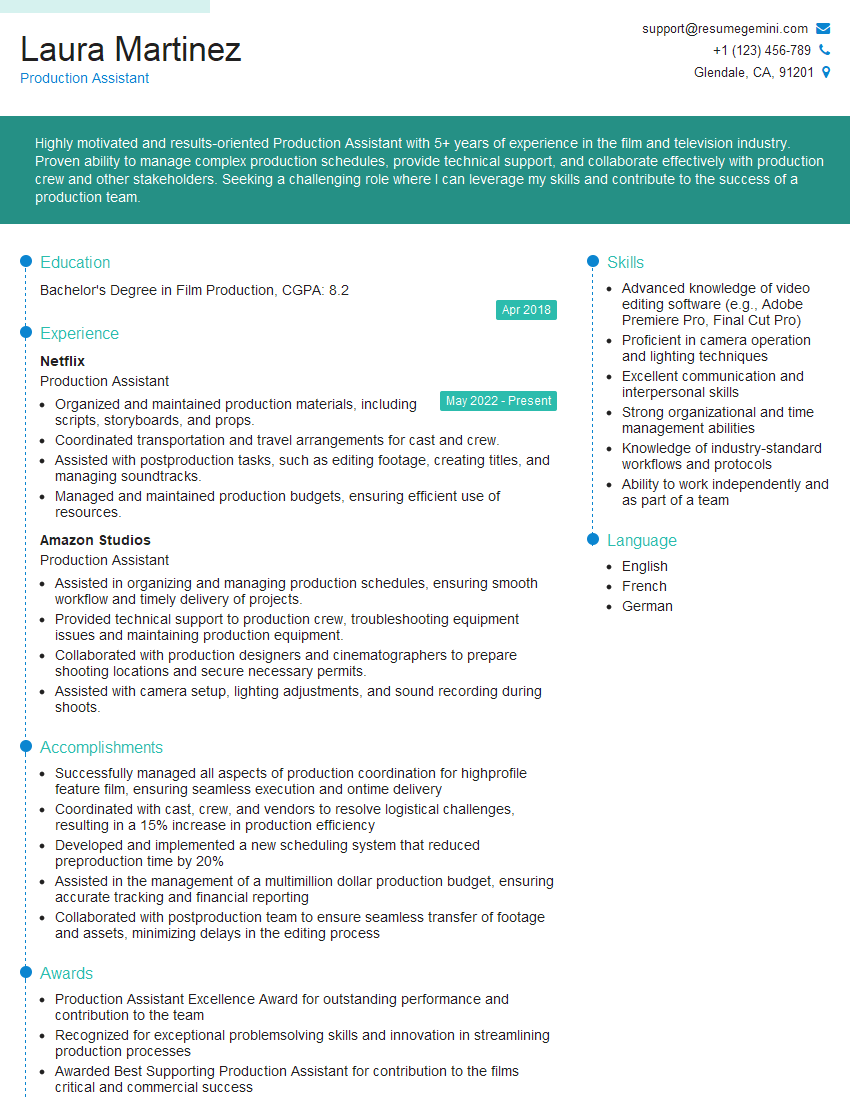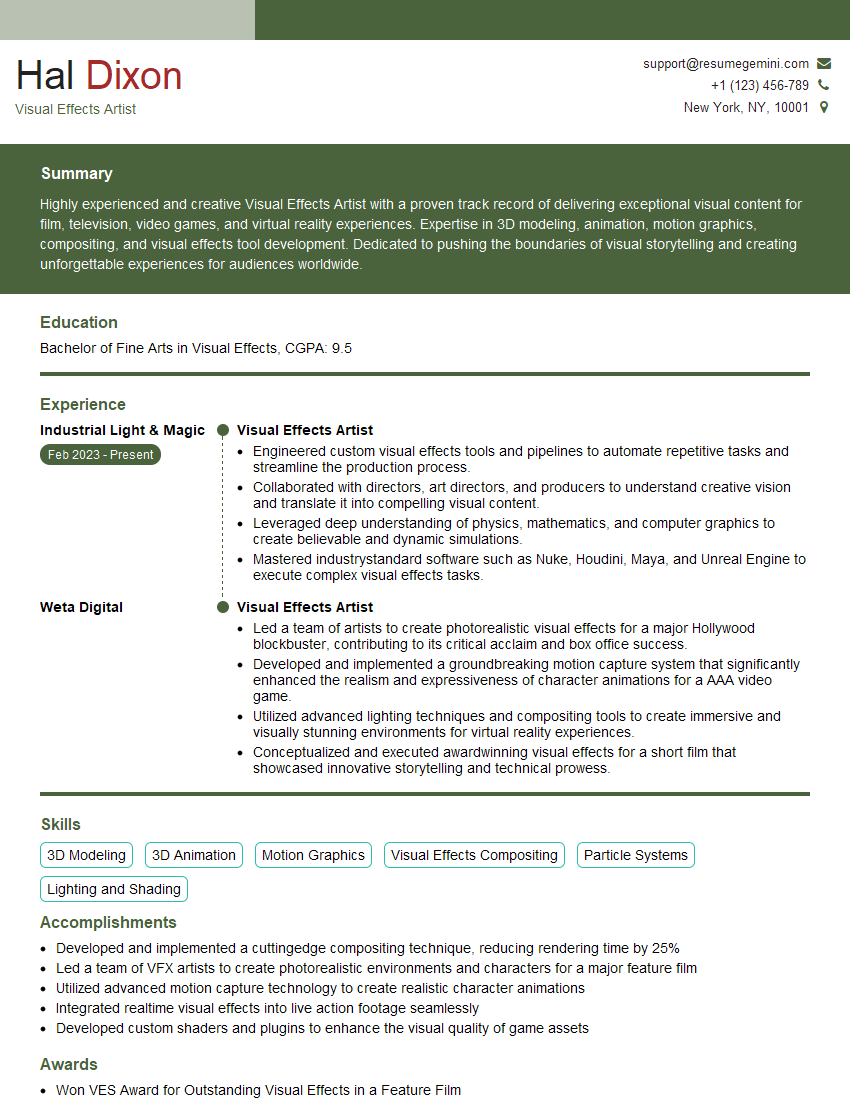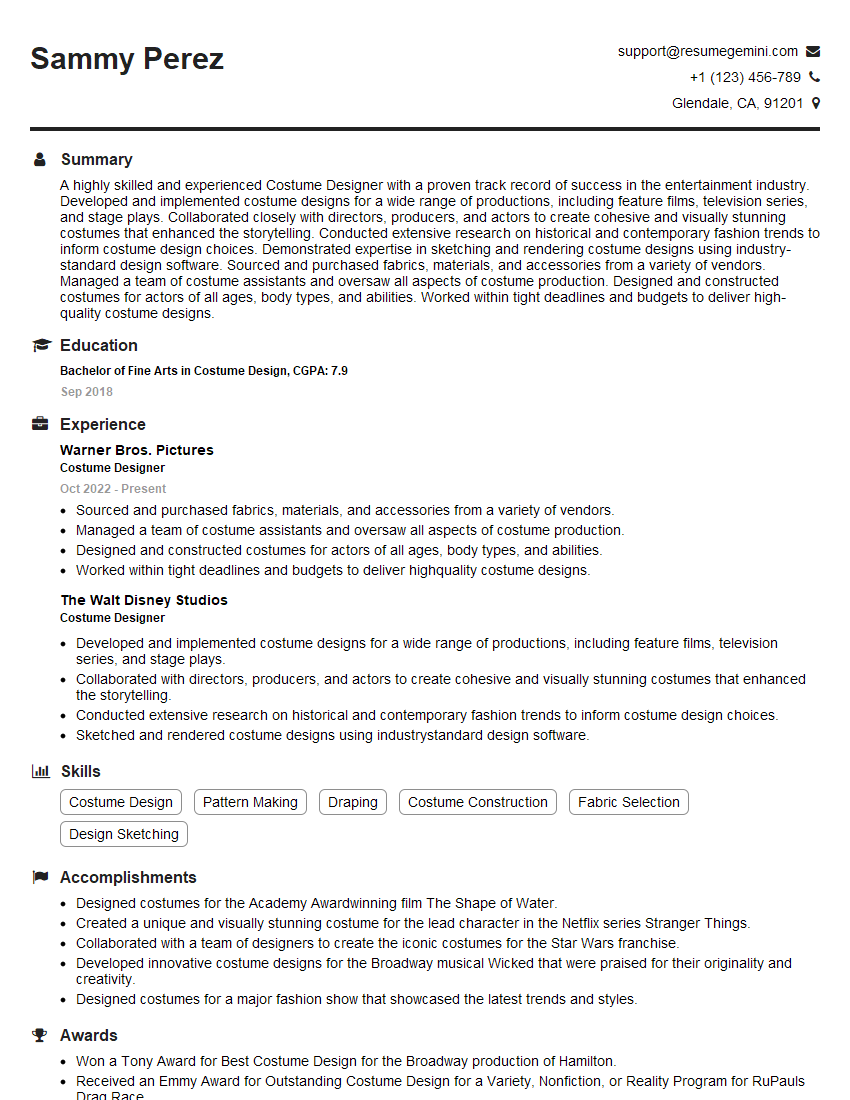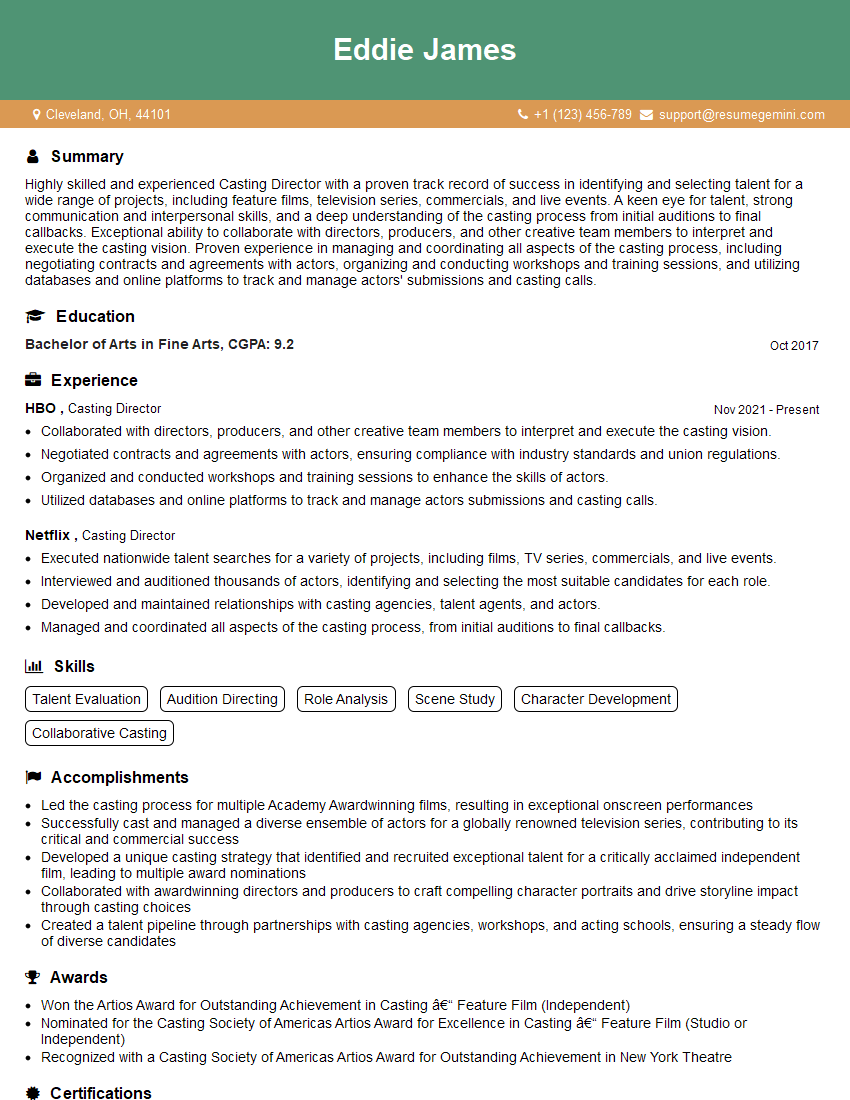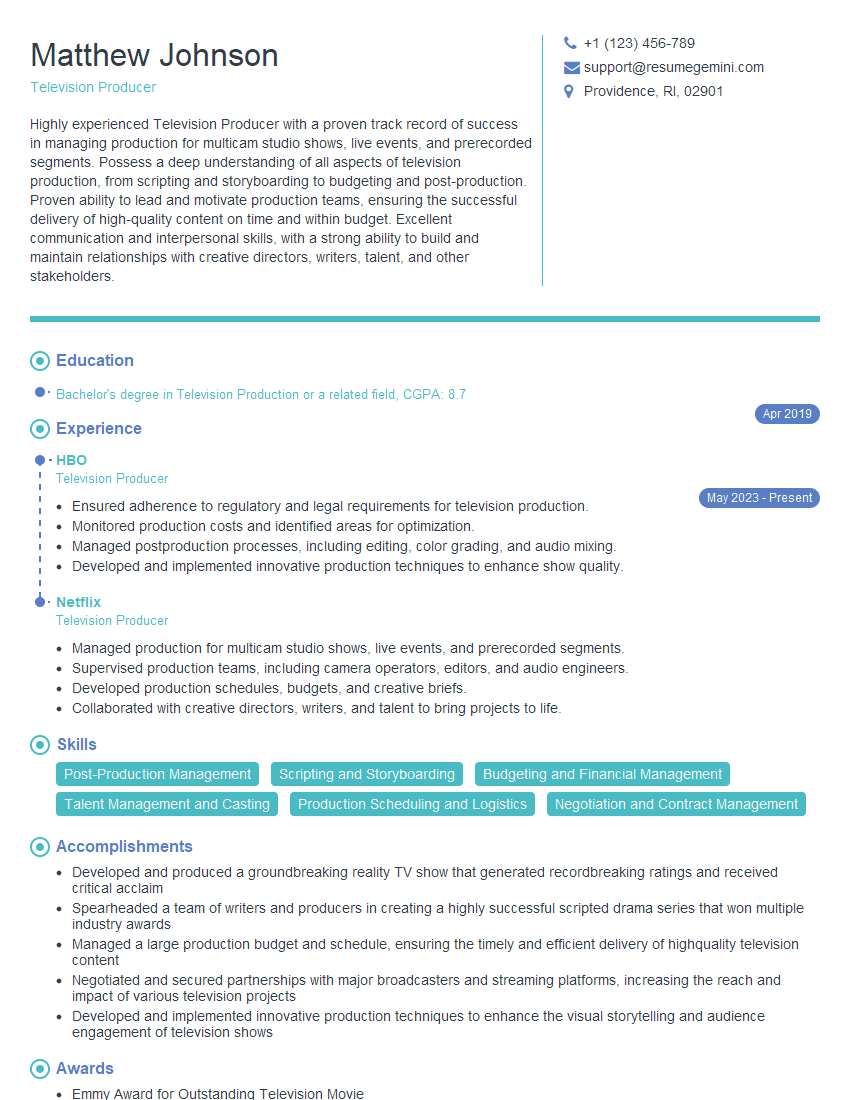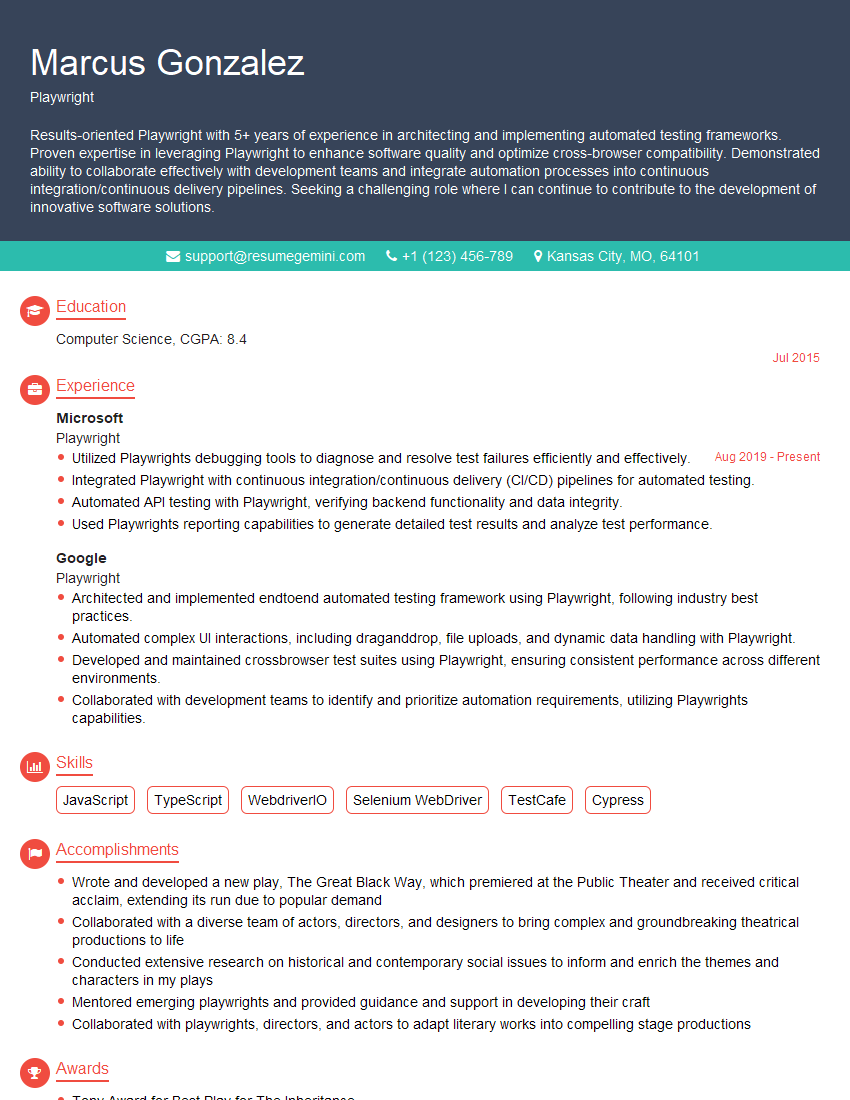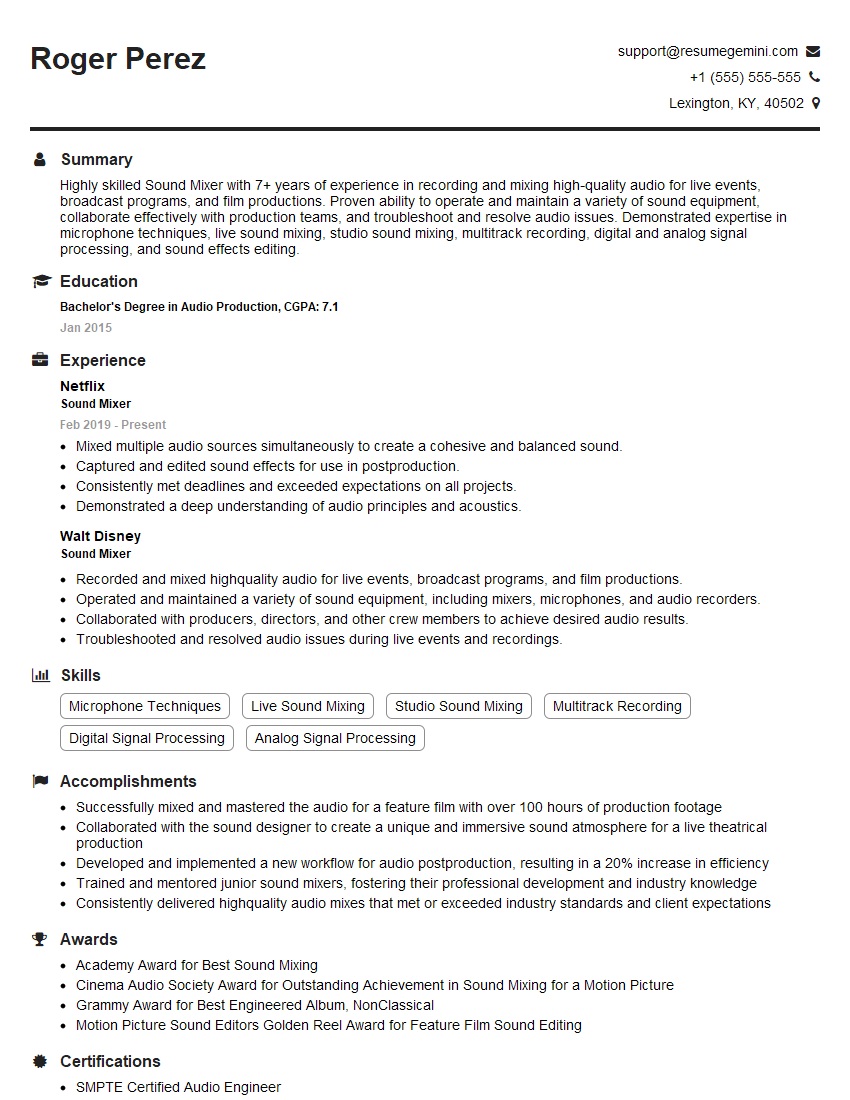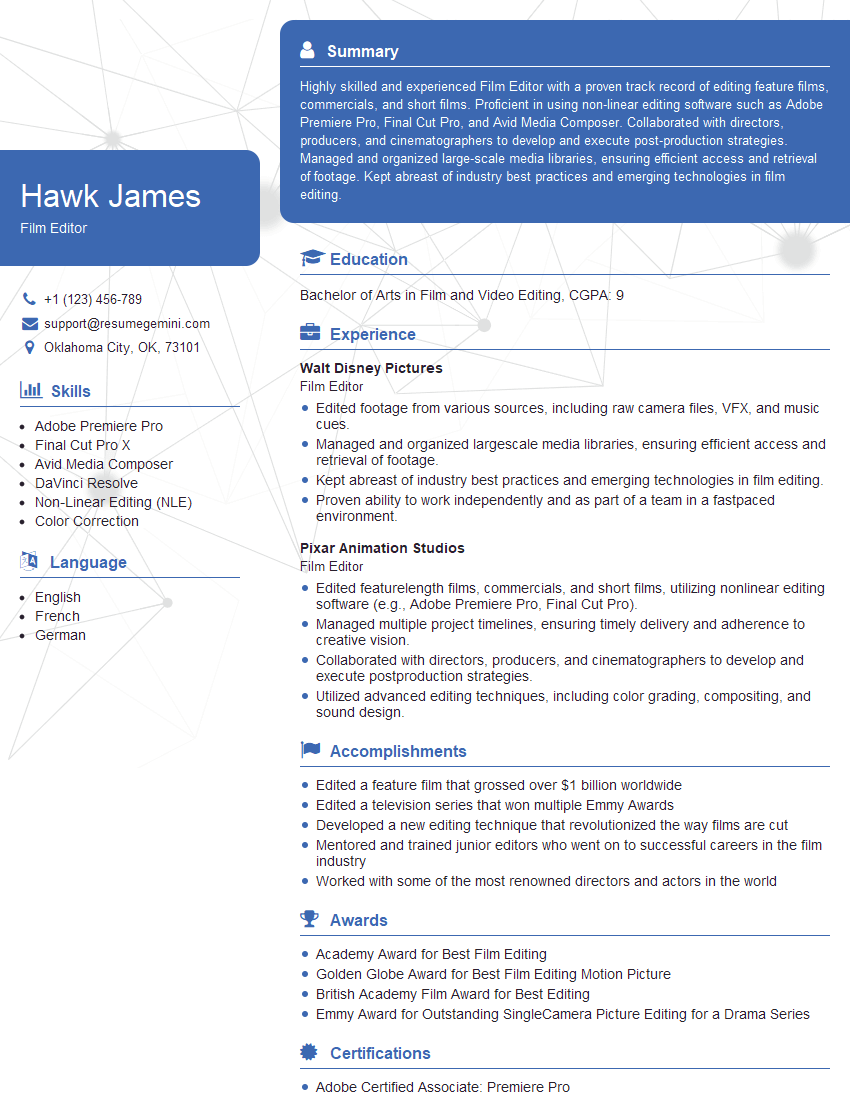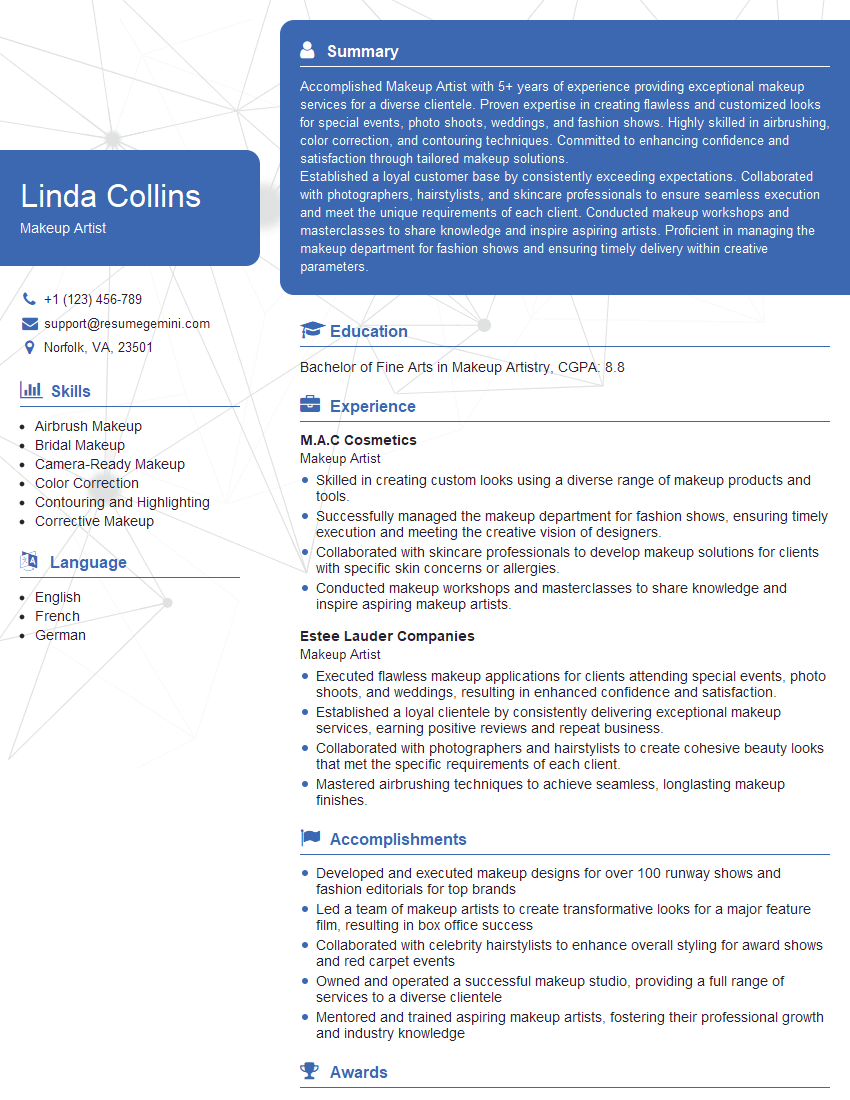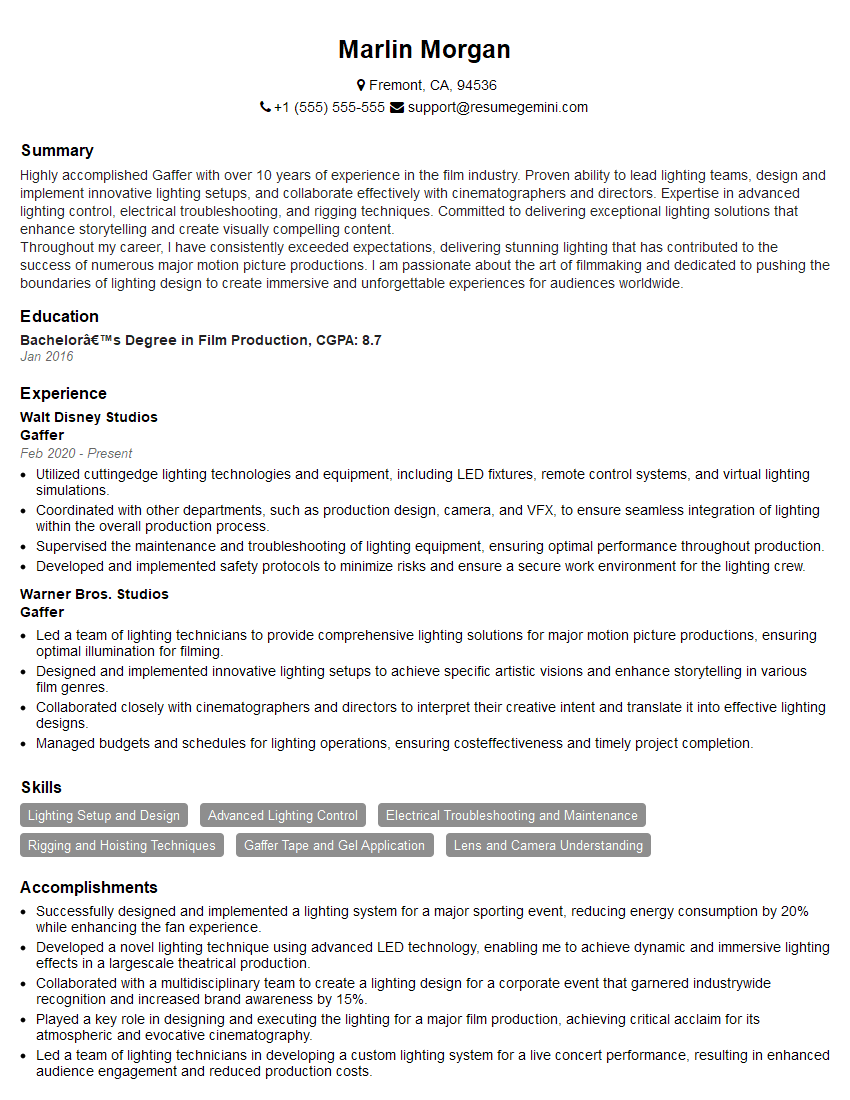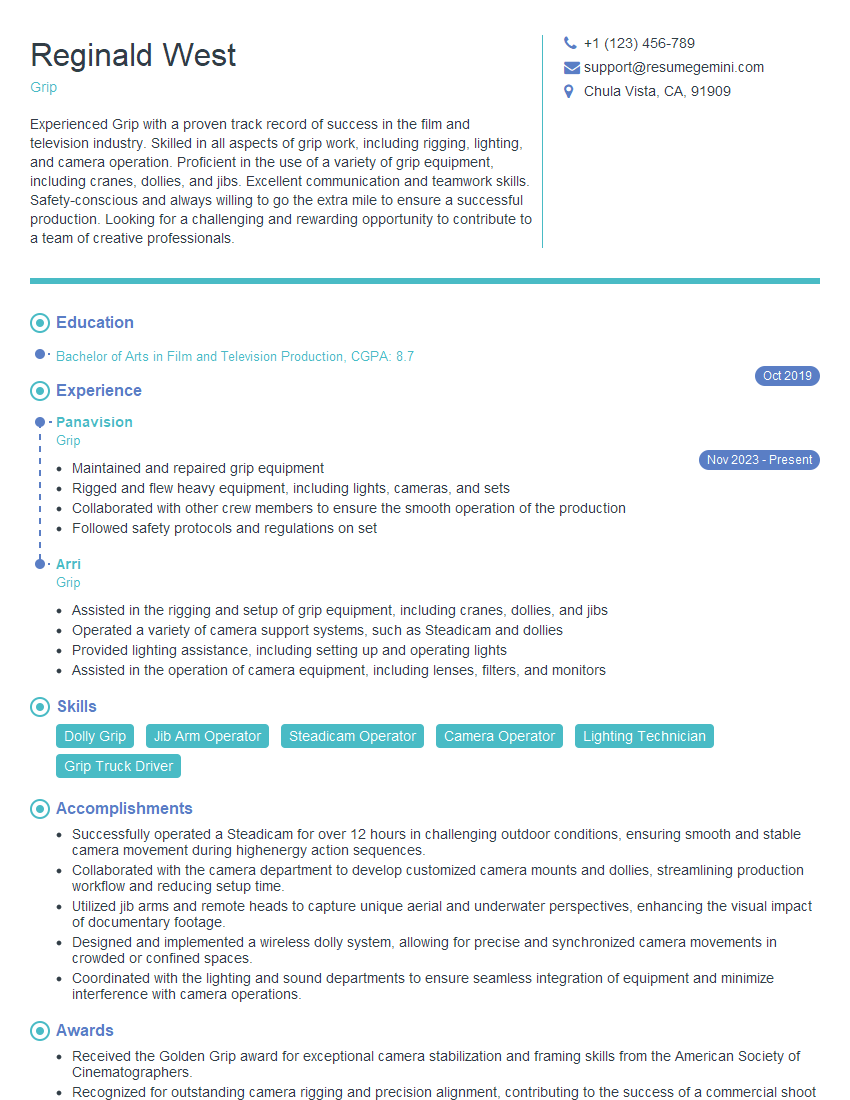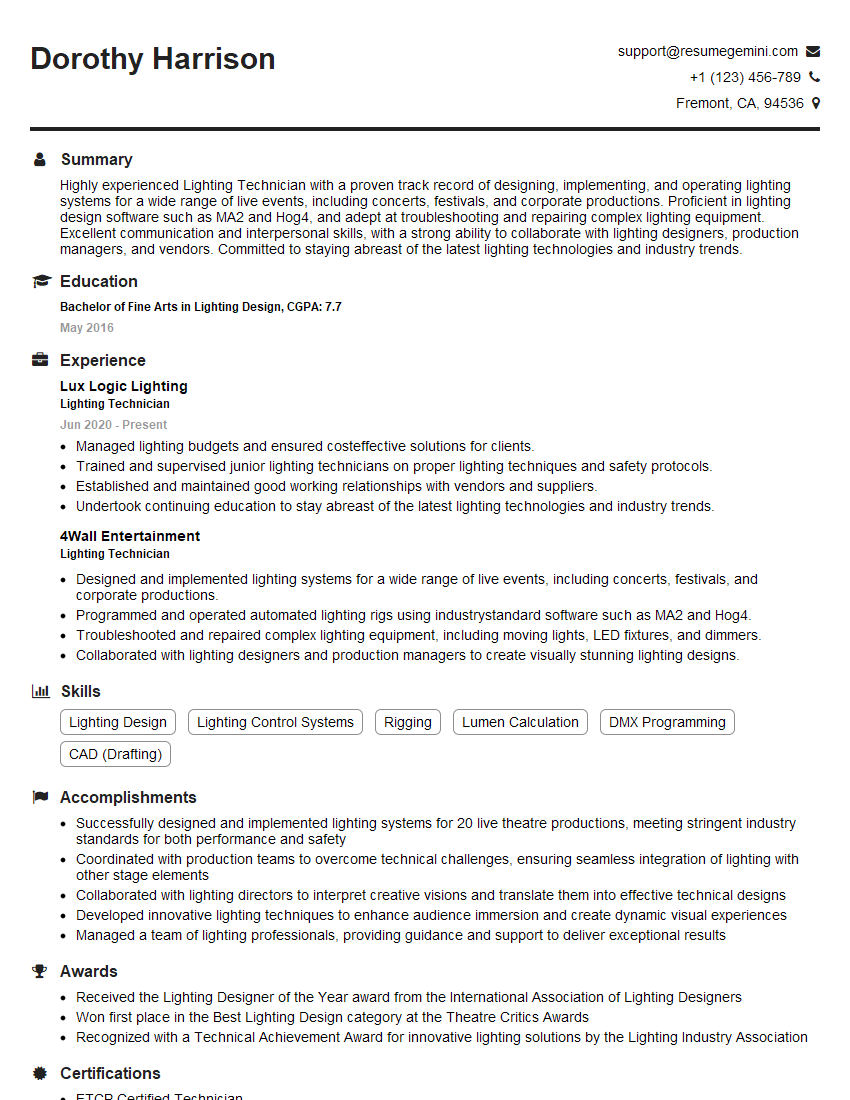Interviews are opportunities to demonstrate your expertise, and this guide is here to help you shine. Explore the essential Experience in Film, Television, Theater, or Video Games interview questions that employers frequently ask, paired with strategies for crafting responses that set you apart from the competition.
Questions Asked in Experience in Film, Television, Theater, or Video Games Interview
Q 1. Explain your experience with different camera angles and their impact on storytelling.
Camera angles are fundamental to storytelling; they dictate the audience’s perspective and emotional engagement with the narrative. Different angles evoke different feelings and provide varied information. For instance, a high angle shot can make a character appear vulnerable or insignificant, while a low angle shot can portray them as powerful or intimidating.
- Eye-level shots: These are neutral and create a sense of connection with the character.
- High-angle shots: These shots often depict vulnerability, weakness, or inferiority.
- Low-angle shots: These shots typically portray power, dominance, or even menace.
- Over-the-shoulder shots: These provide intimacy and perspective from one character’s viewpoint to another, often used during dialogue.
- Dutch angles (canted angles): These create a sense of unease, disorientation, or chaos.
In a recent project, a scene required showing a protagonist feeling overwhelmed by a powerful antagonist. We used a series of high-angle shots on the protagonist interspersed with low-angle shots of the antagonist to visually communicate the power dynamic and the protagonist’s emotional state. The shift in camera angles reinforced the dramatic tension.
Q 2. Describe your workflow for editing a scene, focusing on pacing and emotional impact.
My editing workflow prioritizes pacing and emotional impact. It’s a meticulous process that starts long before I even touch the editing software. I begin by reviewing the footage and creating a rough cut, focusing on the narrative flow. This involves selecting the best takes and sequencing them to tell a compelling story.
Then, I meticulously refine the pacing. I use techniques like jump cuts (for fast pacing) and slow motion (for emphasis) to control the rhythm. I pay close attention to the timing of dialogue, music, and sound effects, ensuring they complement the visuals. The emotional impact is a crucial consideration; music cues and subtle edits can greatly enhance or change the tone of a scene.
For example, a scene showcasing grief might utilize longer takes and slower cuts, punctuated with poignant musical cues. A scene involving action, however, requires faster cuts and dynamic editing to enhance the energy. Software like Adobe Premiere Pro is my primary tool for fine-tuning every detail, from trimming shots and adjusting transitions to color correction and sound design integration.
Q 3. How do you manage creative differences within a team environment?
Managing creative differences is crucial for a successful production. My approach emphasizes open communication, collaboration, and mutual respect. I encourage everyone to voice their ideas and opinions, creating a safe environment for brainstorming. We often utilize storyboarding and shot lists, which provide a visual representation of the scene before shooting to minimize conflict. I prioritize finding common ground and creatively merging different perspectives.
If a conflict arises, I facilitate a discussion, encouraging all parties to articulate their viewpoints clearly. We analyze the creative goals and the technical feasibility of each suggestion before making a decision. The final decision might be a compromise or a vote. Transparency and the willingness to hear all parties are essential, leading to a better result.
Q 4. What software are you proficient in for your specific role?
My proficiency spans various software essential to film and video production. I am highly proficient in Adobe Creative Suite, including Premiere Pro (video editing), After Effects (visual effects and motion graphics), and Audition (audio editing). I also have experience with DaVinci Resolve (color grading) and Cinema 4D (3D modeling and animation). My skill set allows me to manage almost every stage of post-production effectively.
Q 5. Explain your understanding of color grading and its effect on mood and tone.
Color grading is more than just making a video look pretty; it’s a powerful tool for shaping mood and tone. The choice of color palette greatly influences the viewer’s emotional response. Warm colors (reds, oranges, yellows) often convey feelings of happiness, excitement, or anger, while cool colors (blues, greens) can evoke sadness, tranquility, or mystery.
For instance, a scene set in a dark, gritty city might use desaturated colors and deep shadows to enhance its mood of suspense or danger. Conversely, a romantic scene might utilize warm, vibrant colors to emphasize intimacy and affection. In a recent project, we used a desaturated, cool color palette during a flashback sequence to visually distinguish it from the present timeline. This gave it a distinct, melancholic mood. Software like DaVinci Resolve allows me to precisely control every aspect of color correction, saturation, and contrast, sculpting the visual narrative accordingly.
Q 6. How do you approach budgeting and scheduling within a production?
Budgeting and scheduling are crucial for a smooth and efficient production. I use a combination of software and meticulous planning. I create a detailed budget breakdown, encompassing all aspects: crew costs, equipment rentals, location fees, and post-production expenses. A comprehensive schedule is equally crucial, defining shooting days, post-production timelines, and delivery dates. Contingency planning is essential to address unexpected delays or cost overruns.
Communication is vital during this phase. Regular progress reports are key for transparency, ensuring everyone is on the same page. Software like ShotGrid helps to streamline the process and facilitate the collaboration needed to stay on track with both budget and scheduling. Effective communication and proactive problem-solving greatly reduce the chance of overruns or schedule slips.
Q 7. Describe your experience with sound design, including mixing and mastering.
Sound design is an integral part of filmmaking, often underestimated. It encompasses the selection, mixing, and mastering of all audio elements to create an immersive soundscape that complements the visuals. This involves designing and implementing sound effects, music scoring, and dialogue editing.
My experience includes both Foley recording (creating sound effects) and dialogue cleanup. I use software like Adobe Audition for sound design, mixing, and mastering, employing techniques such as equalization, compression, and reverb to achieve the desired sonic quality. For instance, in a scene depicting a quiet forest, detailed sounds of rustling leaves and distant birds would add a sense of realism. In a high-action scene, a well-designed soundscape would increase the impact of the narrative. A clear and consistent sound mix is just as essential as the visuals; poor audio can seriously detract from the overall impact of any project.
Q 8. What strategies do you use to ensure on-time and within-budget project delivery?
Ensuring on-time and within-budget project delivery relies on meticulous planning and proactive management. It’s less about reacting to problems and more about preventing them. My strategy involves a multi-pronged approach:
- Detailed Pre-Production Planning: This includes a comprehensive budget breakdown, a meticulously crafted schedule with clear milestones and deadlines (using tools like Gantt charts), and a thorough risk assessment identifying potential roadblocks and devising contingency plans. For example, I’d allocate buffer time for unforeseen technical issues or actor availability conflicts.
- Regular Progress Tracking and Communication: Daily stand-up meetings, weekly progress reports, and consistent communication with the team and stakeholders are crucial. This allows for early detection of any deviations from the plan, enabling swift corrective actions. Using project management software like Asana or Jira is essential for task assignment, tracking progress, and managing resources effectively.
- Resource Allocation and Management: Efficient allocation of personnel, equipment, and budget is critical. This involves careful forecasting of resource needs, optimized scheduling to avoid conflicts, and strategic outsourcing where appropriate to manage workload and expertise requirements. For instance, hiring a specialized VFX team for a complex sequence might be more cost-effective and time-saving than trying to complete it in-house.
- Scope Management and Change Control: Any changes to the project scope must be rigorously evaluated, documented, and approved. This helps maintain budget and schedule control. A formal change request process ensures that any alterations are properly accounted for and their impact is assessed.
By combining these strategies, I’ve consistently delivered projects on time and within budget, fostering a productive and stress-free work environment.
Q 9. Describe a challenging production issue you faced and how you solved it.
During the production of an independent film, we faced a significant challenge when our lead actor unexpectedly fell ill a week before principal photography was scheduled to begin. This threatened to derail the entire project, as securing a suitable replacement on short notice seemed impossible.
My solution involved a three-step process:
- Immediate Damage Control: We immediately contacted our casting director, and began a frantic search for a suitable replacement, considering both the actor’s established screen presence and the time constraints. We reviewed our initial casting list and actively sought new recommendations.
- Creative Adaptation: Since finding an exact match was highly unlikely, we collaborated with the scriptwriter to make minor adjustments to the script to align with the replacement actor’s strengths. For example, scenes that heavily relied on the original actor’s physicality were modified or repositioned.
- Efficient Rescheduling: We managed to find an actor with a similar profile and acting style who was immediately available. While the rescheduling caused some initial budget pressure, we minimized disruption by prioritizing key scenes involving our lead and efficiently rearranging the schedule around the new actor’s availability.
This issue highlighted the importance of having a robust contingency plan, a flexible mindset, and a collaborative spirit in the face of unexpected events.
Q 10. Explain your understanding of storyboarding and its application to your field.
Storyboarding is a crucial pre-visualization technique, providing a visual roadmap for the narrative and technical aspects of any production. It’s essentially a series of illustrated panels depicting key scenes, shot compositions, and character movements. In my field, it’s indispensable for:
- Pre-Production Planning: Storyboards help directors, cinematographers, and other crew members understand the director’s vision, ensuring everyone is on the same page. They allow for discussion of shot composition, camera angles, and visual effects before any filming or animation begins.
- Budgeting and Scheduling: Storyboards assist in accurately estimating production costs and creating realistic schedules. By visualizing each shot, we can identify complex scenes that require more time, resources, and special effects, allowing us to budget appropriately.
- Communication and Collaboration: Storyboards serve as a visual communication tool between the director and the crew, effectively conveying the overall vision and ensuring alignment throughout the production process.
- Visual Effects Planning: In projects with visual effects (VFX), storyboards are critical for planning the shots and providing a foundation for VFX artists. They can pinpoint precisely where VFX will be required and help determine the necessary scope of work.
For example, when working on a fantasy film, storyboarding helped establish the scale of a massive battle scene, defining camera movements and allowing the visual effects team to anticipate the necessary level of CGI detail.
Q 11. How do you collaborate effectively with actors or voice actors?
Effective collaboration with actors and voice actors relies on building trust, clear communication, and mutual respect. My approach emphasizes:
- Open Communication and Collaboration: I encourage open dialogue and collaboration, providing actors with ample opportunity to offer their input and interpretations. I believe their insights are invaluable.
- Rehearsals and Feedback: Thorough rehearsals allow actors to explore their characters and develop a strong understanding of their roles. Providing constructive feedback ensures performances align with the overall vision while encouraging creativity and spontaneity.
- Respectful Direction: I approach direction with respect and empathy, understanding that each actor brings a unique perspective and creative energy. I aim to create a safe and supportive environment where they feel comfortable taking risks and exploring their characters fully.
- Clear Communication of Expectations: Before rehearsals and shoots begin, I clearly communicate the characters’ motivations, emotional arcs, and any specific directorial notes. I use storyboards and other visual aids to explain the desired shots and scenes. This prevents misunderstandings and maximizes efficiency.
- Recording and Review Sessions (for Voice Actors): With voice actors, we often conduct recording sessions in a comfortable studio environment with a director present to guide them through the emotional aspects of the roles. Providing feedback immediately on the recording allows us to fine-tune performances effectively.
By fostering a collaborative and communicative environment, I’ve consistently achieved exceptional performances from actors across numerous projects.
Q 12. Describe your approach to creating realistic or stylized characters.
Creating realistic or stylized characters involves a multifaceted approach, blending artistic skill with a deep understanding of anatomy, physiology, and character design principles.
For realistic characters, I focus on:
- Accurate Anatomy and Proportions: A thorough understanding of human anatomy and muscle structure is fundamental to creating believable characters. I often use anatomical references to ensure accuracy in the characters’ forms.
- Detailed Texturing and Shading: Realistic skin texture, subtle wrinkles, and realistic hair simulation are all crucial elements in achieving a lifelike appearance. Advanced software like ZBrush and Substance Painter are essential tools.
- Subtle Expressions and Movements: Realistic characters need believable facial expressions and body language. I carefully study human behavior to capture subtle nuances.
For stylized characters, my approach shifts towards:
- Exaggeration and Simplification: Stylization often involves exaggerating specific features or simplifying the overall form. I might emphasize particular aspects of a design, such as large eyes or elongated limbs, to create a unique visual aesthetic.
- Creative Color Palettes and Texture Variations: Color and texture play a crucial role in stylized characters, allowing me to experiment with unique palettes and materials to add visual interest.
- Unique Design Language: I aim to create a consistent visual language, ensuring that the characters’ style remains coherent and recognizable.
Whether creating realistic or stylized characters, I emphasize careful consideration of their role within the narrative and their overall contribution to the visual style of the project.
Q 13. How familiar are you with different lighting techniques and their effects?
Lighting is a pivotal element in filmmaking, animation, and game development, impacting mood, atmosphere, and visual storytelling. My familiarity with lighting techniques encompasses a broad range:
- Three-Point Lighting: This fundamental technique utilizes a key light, fill light, and backlight to illuminate a subject, creating depth and shaping its form. I adjust the intensity and position of these lights to control shadows and highlights.
- High-Key and Low-Key Lighting: High-key lighting emphasizes bright, even illumination, creating a cheerful and optimistic mood, while low-key lighting uses strong shadows and contrasts to generate a dramatic or mysterious atmosphere. The choice depends on the narrative tone.
- Hard and Soft Lighting: Hard lighting creates sharp, defined shadows, while soft lighting produces diffused illumination with gentle shadows. The choice depends on the desired mood and realism.
- Color Temperature and Color Grading: Understanding color temperature (ranging from cool blues to warm oranges) and using color grading tools to adjust the overall look and mood are essential. For instance, warm lighting can evoke feelings of comfort, while cool lighting can create a sense of unease.
- Practical and Artificial Lighting: I’m proficient in both using practical lights (existing on set) and artificial lighting (through various lamps, LEDs, and other lighting equipment) to achieve the desired visual effects.
My experience encompasses both practical application on film sets and digital lighting techniques within animation and game engines like Unreal Engine or Unity.
Q 14. What experience do you have with motion capture or performance capture technology?
I have extensive experience with motion capture (mocap) and performance capture technology. Mocap focuses primarily on recording body movement, while performance capture also encompasses facial expressions and other performance details.
My experience includes:
- Optical and Inertial Mocap Systems: I’m familiar with both optical systems (using cameras to track markers) and inertial systems (using sensors placed on the actor’s body) and understand their strengths and limitations. Optical systems generally offer higher accuracy, while inertial systems are more portable.
- Data Processing and Cleaning: Raw mocap data often requires cleaning and processing to remove noise and artifacts. I’m skilled in using software like MotionBuilder to edit and refine the captured data.
- Facial Performance Capture: I’ve worked with facial performance capture systems that use cameras and specialized software to record detailed facial expressions, enabling realistic character animation. This frequently involves collaboration with facial animators to refine captured data.
- Integration into Different Engines: I understand the process of integrating the captured performance data into various game engines and animation software, such as Maya and Blender. This is a critical step in achieving realistic character animations.
In a recent project, we used mocap to capture the movements of a martial artist for a video game, greatly enhancing the realism and fluidity of the character’s fighting style. This highlighted the importance of accurate capture, careful processing, and seamless integration with game engine animation systems.
Q 15. How do you handle feedback and criticism on your work?
Feedback is crucial for growth. I approach it constructively, viewing criticism not as personal attacks but as opportunities for improvement. My process involves active listening, clarifying any uncertainties, and then thoughtfully analyzing the feedback’s validity and relevance to the project’s goals. I categorize feedback into actionable points and less relevant suggestions. Actionable points are then prioritized based on their impact and feasibility. For instance, if feedback points to inconsistencies in a character’s design across several scenes in an animation, I prioritize addressing that before refining less impactful elements. I document all feedback, tracking changes made and the rationale behind them. This documentation helps maintain transparency and ensures consistent improvement over the project lifecycle. It also serves as a valuable reference for future projects.
Career Expert Tips:
- Ace those interviews! Prepare effectively by reviewing the Top 50 Most Common Interview Questions on ResumeGemini.
- Navigate your job search with confidence! Explore a wide range of Career Tips on ResumeGemini. Learn about common challenges and recommendations to overcome them.
- Craft the perfect resume! Master the Art of Resume Writing with ResumeGemini’s guide. Showcase your unique qualifications and achievements effectively.
- Don’t miss out on holiday savings! Build your dream resume with ResumeGemini’s ATS optimized templates.
Q 16. Describe your experience with pre-visualization or animatics.
Pre-visualization and animatics are invaluable tools in my workflow. I’ve extensively used them in various projects, ranging from short animated films to interactive game sequences. Pre-visualization typically involves creating rough storyboards or 3D models to block out scenes and camera angles. This helps visualize the narrative flow and identify potential problems early on, saving significant time and resources later. Animatics take this a step further by adding basic animation and sound to the pre-visualization, creating a more dynamic representation of the final product. For example, in a recent game project, we used animatics to test the pacing of a complex action sequence. By animating the rough models and timing the action to the soundtrack, we were able to identify awkward transitions and adjust the choreography before committing to full-scale animation and rendering. This iterative process ensures a smoother, more engaging final product.
Q 17. Explain your understanding of different animation techniques (2D, 3D, stop-motion).
My experience encompasses various animation techniques, each with its own strengths and limitations. 2D animation uses hand-drawn or digitally painted images to create movement, offering a unique artistic style and flexibility. Think of classic Disney films or modern animated series like Adventure Time. 3D animation, on the other hand, uses computer-generated models to create realistic or stylized visuals, providing greater control over lighting, texture, and movement. Examples include Pixar films or modern video game cinematics. Stop-motion animation involves physically manipulating objects (clay, puppets, etc.) frame by frame, creating a distinct tactile aesthetic that’s often used for charming or quirky projects like Wallace & Gromit. Choosing the appropriate technique heavily depends on the project’s style, budget, and the desired level of realism or stylization. I am adept at utilizing the strengths of each technique, often combining them to achieve unique visual effects.
Q 18. How do you ensure consistency in visual style and design across a project?
Maintaining visual consistency is critical for a cohesive and professional-looking project. My approach starts with creating a comprehensive style guide that defines color palettes, character designs, environment styles, and overall aesthetic elements. This guide serves as a central reference point for the entire team. Regular check-ins and reviews of the work-in-progress ensure that the visual style remains consistent throughout the project. I frequently utilize version control systems to track changes and modifications in design assets. Furthermore, I actively engage in collaborative discussions and provide constructive feedback to team members to catch deviations from the established style early on. This proactive approach minimizes costly rework later in the project. In one project, we used a shared online style guide with version history and annotations that allowed us to track even subtle color changes or design iterations, ensuring everyone was working from the same updated vision.
Q 19. Describe your experience with different game engines (Unity, Unreal Engine, etc.).
I have significant experience with both Unity and Unreal Engine, two leading game engines. Unity, known for its ease of use and cross-platform compatibility, has been my primary engine for smaller-scale projects and rapid prototyping. I’ve used its scripting capabilities (C#) extensively to create custom game mechanics and user interfaces. Unreal Engine, on the other hand, excels in producing high-fidelity visuals and realistic environments, making it my go-to choice for projects demanding advanced graphics and complex simulations. I’ve worked with its Blueprint visual scripting system for prototyping and its C++ API for more advanced features. The choice of engine depends entirely on the specific project requirements. For a mobile game with a stylized aesthetic, Unity’s versatility and efficiency are preferred, while for a large-scale AAA title with photorealistic visuals, Unreal Engine’s power is invaluable.
Q 20. How do you handle pressure and deadlines in a fast-paced environment?
Working under pressure and meeting tight deadlines is a routine aspect of my work. My strategy centers around effective time management and prioritization. I break down large tasks into smaller, manageable chunks, setting realistic deadlines for each. I leverage project management tools to track progress and identify potential bottlenecks early on. Open communication with the team is essential; I maintain transparency regarding my progress and any challenges encountered. Proactive problem-solving is key – if a roadblock emerges, I immediately explore alternative solutions and communicate them promptly to the team, proactively seeking assistance if needed. I also prioritize my well-being; ensuring adequate rest and breaks helps maintain focus and prevent burnout in high-pressure situations. In one instance, faced with a critical deadline, I employed a ‘timeboxing’ technique, allocating specific time blocks for each task, which helped maintain focus and avoid distractions.
Q 21. Explain your understanding of game mechanics and level design.
Game mechanics and level design are intrinsically linked in creating engaging gameplay experiences. Game mechanics define the rules and systems that govern player interaction within the game world (e.g., movement, combat, puzzle-solving). Level design, in contrast, focuses on the spatial arrangement of game elements to facilitate these mechanics and create a compelling narrative or challenge. A well-designed level incorporates mechanics seamlessly, providing players with a clear understanding of how to interact with the environment. For example, a platformer might utilize precise jump mechanics complemented by level design that introduces challenging platforming sequences that leverage the jump height and momentum. In another example, a puzzle game might rely on mechanics such as object manipulation and inventory management, where level design strategically places obstacles and clues that encourage players to utilize these mechanics creatively. Effective level design anticipates player behavior and creates a sense of progression and accomplishment, making the game fun and rewarding.
Q 22. How do you test and debug your work to ensure quality assurance?
Quality assurance in film, television, and video games is a multifaceted process. It begins long before the final product is released, starting with thorough script reviews and pre-production planning. During production, my approach involves a combination of testing and debugging techniques.
- Testing: This includes playtesting (for games), screening rough cuts (for film/TV), and conducting focus groups to gather feedback on various aspects like pacing, character development, and overall emotional impact. We utilize both internal and external testing, gathering feedback from diverse audiences.
- Debugging: This focuses on identifying and fixing technical issues. In video games, this might involve tracking down glitches in gameplay or fixing bugs in the game engine. In film/TV, this would mean correcting audio issues, visual inconsistencies, or special effects errors. We use tools like bug tracking software to manage and prioritize identified issues.
For example, during post-production on a recent animated film, we noticed a subtle animation error that only appeared under specific lighting conditions. Our QA team identified it through rigorous testing across various hardware configurations. We then used our bug tracking system to document the problem, assign it to the animation team, and track its progress until it was resolved. The entire process is iterative, involving multiple rounds of testing and debugging to polish the final product. This rigorous process ensures a high-quality final product, delivering a superior experience for the audience.
Q 23. What are your preferred methods for collaborating with other departments (art, programming, etc.)?
Collaboration is crucial in entertainment production. My preferred methods emphasize open communication and proactive problem-solving. I believe in establishing clear communication channels early on.
- Regular Meetings: I advocate for frequent, structured meetings involving representatives from all relevant departments. These meetings are agenda-driven, focusing on specific deliverables and potential roadblocks. This ensures everyone is informed and aligned.
- Collaborative Software: Utilizing project management tools such as Jira or Asana facilitates seamless information sharing, task assignment, and progress tracking. This transparency fosters a collaborative environment, keeping everyone updated on the project’s status.
- Version Control: Using version control systems like Git (for code) and cloud-based platforms for assets ensures that all collaborators have access to the most up-to-date versions of files and can track changes over time. This is particularly important for managing creative assets and code across multiple teams.
- Feedback Loops: Establishing regular feedback cycles, through both formal reviews and informal discussions, encourages open dialogue and ensures everyone’s input is considered. Constructive criticism is vital to improving the final product.
For instance, when working on a video game, I frequently hold daily stand-up meetings with the programming, art, and design teams to ensure everyone is aligned on the current tasks and any challenges that may have arisen. This proactive approach avoids conflicts and keeps the project on schedule.
Q 24. Describe your understanding of different theatrical styles and performance techniques.
My understanding of theatrical styles encompasses a broad range, from classical to contemporary approaches.
- Classical Styles: This includes understanding the conventions of Greek tragedy, Shakespearean drama, and other historical forms. Knowing these styles helps in appreciating the evolution of theatrical techniques and informing modern interpretations.
- Modern Styles: This involves familiarity with various contemporary styles, such as absurdism, realism, naturalism, expressionism, and postmodern theater. Each style has unique characteristics impacting set design, acting choices, and overall audience experience.
- Performance Techniques: A deep understanding of acting techniques – such as Stanislavski’s method, Meisner technique, and others – is critical for both directing and acting. This knowledge allows me to work effectively with actors, guiding their performances to achieve the desired effect.
For example, while directing a production of Shakespeare’s Hamlet, I might incorporate elements of modern staging techniques to make the play accessible to a contemporary audience while still respecting its historical context. This could involve updating the costumes, utilizing modern lighting, and employing innovative set design.
Q 25. How do you manage a diverse team with varying levels of experience?
Managing a diverse team requires fostering an inclusive environment where everyone feels valued and their contributions are recognized.
- Clear Roles and Responsibilities: Defining clear roles and responsibilities from the outset helps to avoid conflicts and ensures each team member understands their contribution to the overall project.
- Mentorship and Training: Providing opportunities for mentorship and training allows less-experienced members to learn from more experienced colleagues, promoting professional growth and team cohesion.
- Open Communication: Encouraging open communication, where team members feel comfortable sharing their ideas and concerns without fear of judgment, is vital to a positive and productive work environment.
- Fair and Consistent Feedback: Providing regular, constructive feedback ensures that all team members are aware of their performance and can identify areas for improvement. This feedback should be delivered fairly and consistently, creating a culture of transparency and accountability.
In a recent project, I mentored a junior animator, providing regular feedback and guidance on their work. This investment led to a significant improvement in their skills and increased their confidence, positively impacting the entire animation team’s output.
Q 26. How do you adapt your communication style to different stakeholders?
Adapting communication styles is essential for effective collaboration with various stakeholders, from creative teams to executives to the public.
- Technical vs. Non-Technical Audiences: When communicating with technical teams, I use precise language and detail. When communicating with executives or the public, I use clear, concise language, avoiding jargon.
- Formal vs. Informal Settings: My communication style adjusts based on the setting. Formal presentations to executives demand structure and professionalism, whereas brainstorming sessions with creative teams encourage a more relaxed and collaborative approach.
- Active Listening: I prioritize active listening to understand each stakeholder’s perspective and tailor my message to address their specific concerns and needs.
- Visual Aids: Employing visual aids such as charts, graphs, and mock-ups when communicating technical or complex information greatly improves comprehension. This is crucial when presenting to non-technical audiences.
For example, when presenting a project budget to executives, I use clear graphs and charts to illustrate financial projections, but when explaining the same budget to the production team, I focus on the impact on scheduling and resource allocation. This customized approach ensures that everyone understands the information relevant to their role.
Q 27. What are your strategies for marketing and promoting a film, TV show, or video game?
Marketing and promotion strategies vary greatly depending on the nature of the project (film, TV, game) and the target audience. However, a successful strategy typically involves a multi-pronged approach.
- Pre-release Buzz Generation: This involves creating excitement and anticipation before the release date. Techniques include using social media, trailers, teasers, and early access programs (for games).
- Targeted Advertising: This involves reaching the specific demographics most likely to be interested in the product. This can be done through targeted online ads, print media, and collaborations with relevant influencers.
- Public Relations: This encompasses press releases, interviews, and attending industry events to generate positive media coverage. This is particularly important for building credibility and creating a strong public image.
- Community Engagement: Especially vital for video games, engaging directly with the community through forums, social media, and streaming platforms creates a loyal fan base and helps with feedback incorporation.
For example, when launching a new video game, we utilized social media to build a community around the game before the release, generating interest through behind-the-scenes footage and developer updates. We also partnered with gaming influencers to create playthroughs and reviews, reaching a wider audience.
Q 28. Describe your understanding of copyright and intellectual property laws in the entertainment industry.
Copyright and intellectual property (IP) laws are critical in the entertainment industry, protecting creative works from unauthorized use.
- Copyright: This protects original creative works, such as scripts, music, artwork, and video game code. Copyright protection is automatic upon creation, but registration provides additional legal advantages.
- Trademarks: These protect brand names, logos, and other identifying marks, preventing others from using similar marks that could cause confusion in the marketplace.
- Patents: These protect inventions, including unique game mechanics or technologies. Patents provide exclusive rights to manufacture, use, and sell the invention.
- Contracts: Clear and comprehensive contracts are crucial to managing IP rights. They outline ownership, usage rights, and compensation for all involved parties.
For instance, securing copyright registration for a film script before production protects the writer’s ownership and prevents unauthorized adaptation or distribution. Furthermore, contracts with actors, musicians, and other creatives clearly define the usage rights of their contributions, avoiding potential disputes down the line.
Key Topics to Learn for Experience in Film, Television, Theater, or Video Games Interviews
- Storytelling & Narrative Structure: Understanding narrative arcs, character development, and pacing across different mediums.
- Production Processes: Familiarize yourself with pre-production, production, and post-production workflows in your chosen field. Be ready to discuss your role in each stage.
- Collaboration & Teamwork: Highlight your experience working within a team, managing creative differences, and contributing to a shared vision.
- Technical Proficiency: Depending on your role, demonstrate knowledge of relevant software, equipment, and techniques (e.g., filmmaking software, stage lighting, game engines).
- Problem-Solving & Adaptability: Prepare examples showcasing your ability to overcome challenges and adapt to unexpected situations on set, in the studio, or during a production.
- Software and Tools: Showcase your proficiency in industry-standard software relevant to your specialization (e.g., Adobe Creative Suite, Unity, Unreal Engine).
- Industry Trends & Best Practices: Demonstrate awareness of current trends, new technologies, and evolving best practices within your field.
- Portfolio & Project Management: Be prepared to discuss your past projects, highlighting your contributions and the challenges you faced. Show how you managed your time and resources effectively.
- Legal and Ethical Considerations: Understand copyright, intellectual property, and other legal considerations relevant to your field.
- Audience Engagement: Discuss how you consider and cater to your target audience in your work.
Next Steps
Mastering the skills and knowledge related to Film, Television, Theater, or Video Games is crucial for career advancement in this dynamic and competitive industry. A strong resume is your first impression – make it count! Creating an ATS-friendly resume significantly increases your chances of getting noticed by recruiters. We highly recommend using ResumeGemini to build a professional and impactful resume tailored to your specific experience and target roles. ResumeGemini provides examples of resumes specifically designed for professionals in Film, Television, Theater, and Video Games, helping you present your skills and experience in the most effective way.
Explore more articles
Users Rating of Our Blogs
Share Your Experience
We value your feedback! Please rate our content and share your thoughts (optional).
What Readers Say About Our Blog
Hello,
We found issues with your domain’s email setup that may be sending your messages to spam or blocking them completely. InboxShield Mini shows you how to fix it in minutes — no tech skills required.
Scan your domain now for details: https://inboxshield-mini.com/
— Adam @ InboxShield Mini
Reply STOP to unsubscribe
Hi, are you owner of interviewgemini.com? What if I told you I could help you find extra time in your schedule, reconnect with leads you didn’t even realize you missed, and bring in more “I want to work with you” conversations, without increasing your ad spend or hiring a full-time employee?
All with a flexible, budget-friendly service that could easily pay for itself. Sounds good?
Would it be nice to jump on a quick 10-minute call so I can show you exactly how we make this work?
Best,
Hapei
Marketing Director
Hey, I know you’re the owner of interviewgemini.com. I’ll be quick.
Fundraising for your business is tough and time-consuming. We make it easier by guaranteeing two private investor meetings each month, for six months. No demos, no pitch events – just direct introductions to active investors matched to your startup.
If youR17;re raising, this could help you build real momentum. Want me to send more info?
Hi, I represent an SEO company that specialises in getting you AI citations and higher rankings on Google. I’d like to offer you a 100% free SEO audit for your website. Would you be interested?
Hi, I represent an SEO company that specialises in getting you AI citations and higher rankings on Google. I’d like to offer you a 100% free SEO audit for your website. Would you be interested?
good


